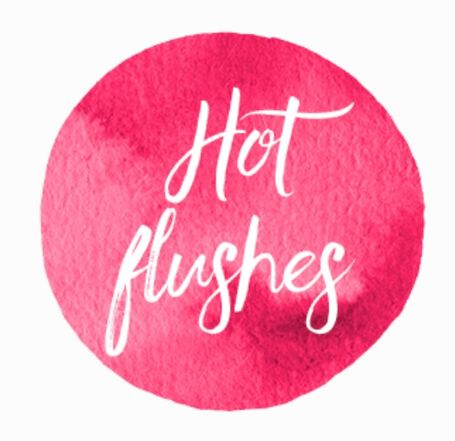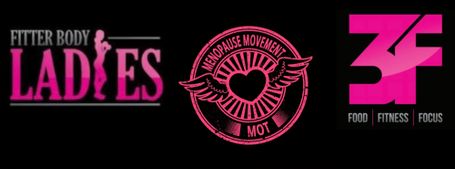
Hot Flushes
Whether it's hot flushes (or hot flashes), night sweats - or both - we all experience them differently.
The bottom line is that hot flushes are miserable, uncomfortable, sometimes embarrassing, draining and always unwelcome.
“Heatwave”! Martha and The Vandellas, sang about a burning in their heart but a hot flush feels like you’re stuck in a ‘Heatwave’ with added high humidity, making you feel 'scorchio'.
WHY NOW?
Fluctuating hormone levels, with oestrogen fleeing the scene, cause hot flushes and night sweats.
As our ovaries stop producing eggs, the hypothalamus, the section of the brain that acts as our body’s thermostat control, goes into overdrive producing hormones to encourage ovulation.
The hormone surges cause ‘vasomotor symptoms’ (the medical term for hot flushes), dilating blood vessels and increasing blood flow to your skin - making you feel hot!
As the body responds to these hormonal surges you can experience an increase in heartbeat and pulse rate, flushes and sweats, followed by a cooling chill as the sweat dries on your body.
What a combination!
And the good news is….
Most women going through a natural menopause transition will find that hot flushes and night sweats will eventually subside.
BE PROACTIVE
The best ways to beat the heat and what to do to stop hot flushes and night sweats
Tweaking your lifestyle, diet, fitness levels, sleep habits and stress management can help, as can a trip to your friendly GP.
What to eat to help with hot flushes
Women in countries eating a diet high in phytoestrogens - naturally occurring plant oestrogens that mimic the effects of our body’s oestrogen - don’t tend to report hot flushes, and the other crazy menopause symptoms that women eating a Western diet often do.
Cultural reasons may also play a part as Japanese women are also reported to experience lower levels of breast cancer!
Although studies on phytoestrogen can sometimes be contradictory.
Approaching menopause get to know your isoflavines from your lignans, as these are the active ingredients in phytoestrogens.
So where do you find them? Not in a packet but found naturally in:
Chick peas, lentils, peas, peanuts, alfalfa and wholemeal rice.
Nuts such as almonds (the menopausal magic nut), cashews and peanuts are high in lignans
Seeds: milled linseed (also called flaxseed), sesame, sunflower and pumpkin
Whole grains, rye, barley and oats, whole wheat, granola, bran and muesli
Soya products: milk, mince, flour, soya beans (found in freezer cabinet), fermented Miso - essential that it is fermented to get the benefit, tofu, and soya based milks and yogurt.
Brassicas (broccoli, sprouts, cabbage, cauliflower, collards, kale, and kohlrabi) are a good source of lignans. Also, peppers, carrots and beans.
Fruits - apricots, peaches and all berries are chock-full of lignans. Also, pears, nectarine, pink grapefruit and cherries.
Phytoestrogens are a hot topic and divide professional opinion. Menopause Matters say that women with breast cancer should be cautious about taking phytoestrogen supplements - with some breast surgeons and cancer specialists advising against ‘even tiny amounts’ of oestrogen. Where there’s a risk to you or a family history of breast cancer, get advice from your GP.
What to avoid to help with hot flushes
Useful to know which every day staples may trigger these heat-generating merciless moments of madness.
Refined sugar and carbohydrates produce heat when processed by the body, contributing to hot flushes. Found in most of your favourite foods: milk chocolate, cakes, biscuits, white bread, pasta and rice. Step away from the biscuit tin and switch to good carbohydrates such as wholemeal bread, pasta and brown rice. Eat 70% (or above) dark chocolate, sparingly
Spices will make you hot. So avoid where you can. Stick to garlic, turmeric, sage and fennel, which may relieve hot flushes.
Caffeine and fizzy drinks are not your friends, containing stimulants that cause blood vessels to dilate, increasing blood flow to the skin and a hot flush.
Don’t light up Smokers are more likely to have hot flushes, which intensify as the nicotine hits the central nervous system. Reduced lung capacity and function will make it more difficult to take deep, slow calming breaths. Get help from your GP if you are finding it difficult to give up.
What about alcohol and hot flushes?
The alcohol in that tempting glass of wine can raise overall body temperature, triggering or adding to the severity of hot flushes. So, make a choice, a refreshing beer or a hot flush?
Lifestyle & wellbeing to help with hot flushes
Control your environment
Turn heating controls down. Layer up your clothes so you can strip down when needed. Synthetic fabrics can make you sweat more so try to wear cotton instead, it wicks sweat away from your body. Open windows where possible.
Essential oils for the heat of the moment…
Try clary sage, thyme, peppermint or roman chamomile: rub a couple of drops onto palms of hands, back of neck or feet. If you’re on the move, put 1-2 drops on a tissue, inhale, focus and cool down!
Carry a cooling peppermint spritzer spray. Buy or make your own: 3-5 drops of peppermint oil to 50ml water. Mix, shake, and as an added cooling bonus, store it in the fridge
EXERCISE
Exercise helps with hot flushes
The Royal College of Obstetricians and Gynaecologists recommend exercise as a safe, effective treatment for hot flushes in place of HRT (exercise may help train the body to control its temperature). Try:
Regular aerobic exercise: running and swimming
When time is a factor take a none-joint-jarring, fast walk during your lunch break or try and build in a walk when previously you might have driven or taken a bus. Walking moves from low to medium intensity exercise when you start sweating and breathing harder.
Low-intensity exercise: stretching, yoga, walking, hula-hooping.
Keep calm to keep cool
As stress levels rise, hot-flush rates increase as adrenaline surges, causing your heart to beat faster and raising your temperature. So, stress makes hot flushes worse, yet, hot flushes accompanied by feeling out of control can raise your stress levels. What a double whammy!
Women suffering from anxiety before the menopause may suffer more intense hot flushes. Look into stress management techniques: yoga, mindfulness, exercise, dance or a relaxing hobby.
Controlled breathing calms down the over-stimulated sympathetic nervous system which control your hot flushes. Make time twice a day to practice.
An App to cool your hot flushes
Clarity is a Mindfulness App designed specifically with menopausal women in mind. Download it on the Appstore to be eased through your hot flushes.
Cooling cloth for hot women
Technological advances in textiles has seen newly developed brands that supply moisture wicking products to relieve hot flushes. Clothing brands include Fifty One Apparel, Become and Cucumber Clothing.
There’s also bedding from DermaTherapy made from an antimicrobial nylon-polyester blend claiming to absorb water 60% faster than cotton bedding, helping maintain freshness with its special ‘soil release’ mechanism to keep the fabric clean. All helpful qualities for those experiencing menopause night sweats
Supplements worth trying for hot flushes
There are as many supplements on offer as shades of Hot Flush red, pink and crimson. It’s easy to be tempted by a little bottle of pills promising the end of your hot flush hell. Be advised that these contain phytoestrogens or have oestrogen like properties and shouldn’t be taken if you have hormone positive breast cancer.
Black Cohosh
Red Clover
Agnus Castus
Dong Quai
Siberian Ginseng
Evening Primrose Oil
These supplements are not phytoestrogenic and are linked with reducing hot flushes:
Pine Bark Supplement
Folic acid
Vitamin C and E
Sage supplements
There are specific menopause supplements such as A.Vogel’s Menopace plus Promensil’s Red Clover Isoflavins, (Promensil also do a lovely cooling spray specifically developed for tackling hot flushes, night sweats and redness. Look for products carrying the Traditional Herbal Registration (THR) symbol or product license number which means a product is made to good quality standards with appropriate labelling and a product information leaflet - independent herbalists like G Baldwin have a huge online range and should be able to recommend the best product for you.
Alternative help for hot flushes
The British Acupuncture Council says small studies have shown acupuncture ‘is at least as effective, and sometimes superior to, ‘hormonal drug treatment’ for hot flushes. Other studies say that any benefits are down to the placebo effect – but you may not care if it reduces your hot flushes?
Homeopathy
A homeopathic remedy is created to fit the overall profile of an individual. There isn’t a specific one-stop homeopathic remedy to treat hot flushes although Pulsatilla and Sepia are often prescribed.
Heaven is a – hot flush free - place on earth! Belinda Carlisle, the lead singer of the Go-Go’s, suffered from dreadful hot flushes in her forties. She thinks that wearing a magnet in her knickers did away with her hot flushes. The Royal College of Gynaecology aren’t convinced about their effectiveness. Seems, it may or may no have a placebo effect, but if it works for you, it works! Try CBT to change your response to those hot moments Cognitive behavioural therapy (CBT) helps you to change how you react to events. Understanding that the way you think about a hot flush affects your response means that you can re-train yourself so that your response calms your body and mind. A 2012 study published in the journal Menopause, found that a staggering 65% of women reported a fall in the number and intensity of their hot flush symptoms after using CBT. Worth considering?
When to see your doctor about hot flushes
What’s in the doctor’s bag for hot flushes? There are drug treatments available for relieving hot flushes. It might be worth discussing these with your GP. Clonidine – a high-blood pressure medication used for anxiety disorders and hot flushes. The Royal College of Gynaecology say patches are more effective than tablets. Gabapentin – an anti-epilepsy medication prescribed for hot flushes. It may cause tiredness, but at least the flushes would stop Big news about a ‘game-changing’ treatment for Hot Flushes Exciting findings from Imperial College’s early stage research trials of the compound MLE4901, which targets receptors in the brain to block the effects of neurokinin, a hormone that causes hot flushes. The study originally published in The Lancet (April 2017) with updates shared in March 2018, found a reduction in the frequency and intensity of hot flushes in 73% of the women who took part in the study, in just 3 days! The lead scientist on the study called this a ‘game-changer’ for women experiencing more than 7 hot flushes a day. We couldn't agree more! A similar compound is now under development in the USA and it's hoped that a prescription drug may be available in in the next 3 years, so maybe 2021. It’s hoped that in future, it can be prescribed for women who can’t take HRT or those who are taking it but still experience hot flushes and those who prefer not to take it because of safety concerns. Watch this space.
And then there’s always HRT…
Depending on the severity and frequency of your hot flushes, you may want to consider HRT. The usual caveat here is that this is something to be discussed with your GP. There are pros and cons to taking HRT. If you want to understand more about the various options of HRT see our YouTube vlog, What is HRT? and our conversation with gynaecologist, Dr Karen Morton Talking HRT . We don’t take a view. HRT is your own personal choice, so make an informed decision! Read Faqs About Hormone Replacement therapy (HRT).
And we can help
Your Fbl Team x
© Copyright. All rights reserved.
